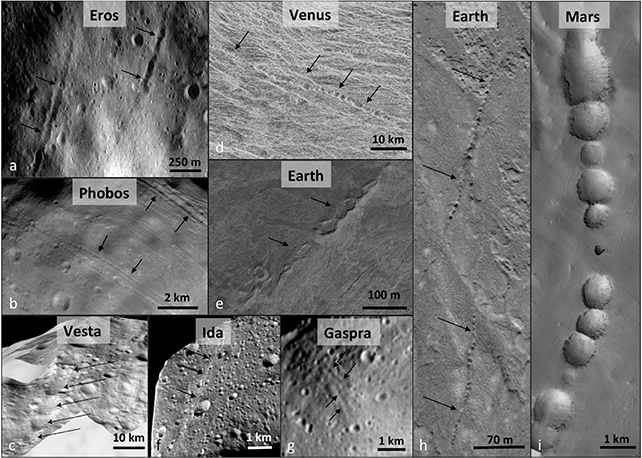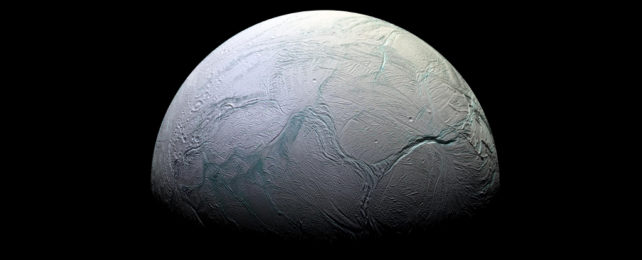Saturn's own orbiting winter wonderland, Enceladus, could be in the midst of a relative dry spell, according to new measures on the thickness of its snowdrifts by a team of researchers from across the US.
Calculations based on the sizes of a series of depressions called tectonic pit chains suggest the deposits of ice particles dropping out of polar geysers could be up to 700 meters (about 2,300 feet) deep in some places, something current eruptions can't account for.
The findings could mean the frozen moon had far more active moments in its past, according to a new study led by first author and research physical scientist Emily Martin from the National Air and Space Museum.
Though a mere 500 kilometers (just over 300 miles) in diameter, Enceladus is the sparkling jewel in Saturn's frozen crown. Not only is the moon covered in a highly reflective shell of ice, it harbors a deep, liquid ocean of salty water just begging to be explored for signs of life.
Thanks to a regular tug-of-war between Saturn and the more distant moon Dione, Enceladus's frozen shell is regularly massaged by tidal forces, to the point that cracks form in the thinner regions of the crust by the moon's south pole.
Pressurized liquid water forces its way into these cracks, where it expands and vaporizes, erupting into a supersonic blizzard of snap-frozen particles in the near vacuum.
A portion of this frozen ocean spray falls into orbit around Saturn, contributing to its glorious rings. Heavier particles tumble back onto the moon's surface, piling into drifts of what planetary scientists classify as a form of regolith.
In 2017, US researchers published high-resolution images from the Cassini mission detailing what they argued were geological formations called pit chains dotting the surface of Enceladus.
On other planetary bodies, including Earth, these crater-like structures can form when surface material suddenly sinks into a void, such as lava tubes or karst cave systems.

Ruling out a source of impacts and a range of other geological activities, planetary scientists concluded the circular and elliptical pits – some up to a kilometer across – were formed as fractures in the crust beneath loose drifts of regolith extended and widened.
Conveniently, the width and depth of the pits themselves can tell researchers something about the properties and formation of the regolith crumbling into them, including an approximation of its thickness.
Applied to the craters on Enceladus, the formulae revealed thicknesses of snow averaging around 250 meters, with some depths adding up to around 700 meters.
Taking into account the rate at which plumes of icy ocean water could deliver an appropriate amount of snow, one way Enceladus could lay down enough snow in the past few billion years of the moon's potential existence would be if the drifts were as fluffy and porous as possible.
Though not completely out of the question, it's more likely that the snow contains a mix of densities and porosities, prompting the researchers to suggest the rate of snowfall had to have occasionally been much greater in the past.
That means the geysers might have been positively roaring at one point, or there were additional plumes spewing out frozen water vapor in Enceladus's history. If not both.
Knowing just how thick and fluffy the moon's dusting of snow is at critical locations would be vital for landing probes on its surface in the future.
In the meantime, understanding better how cryovolcanic activity has evolved on Enceladus gives us fresh insights into one of the Solar System's most fascinating bodies.
This research was published in Icarus.
